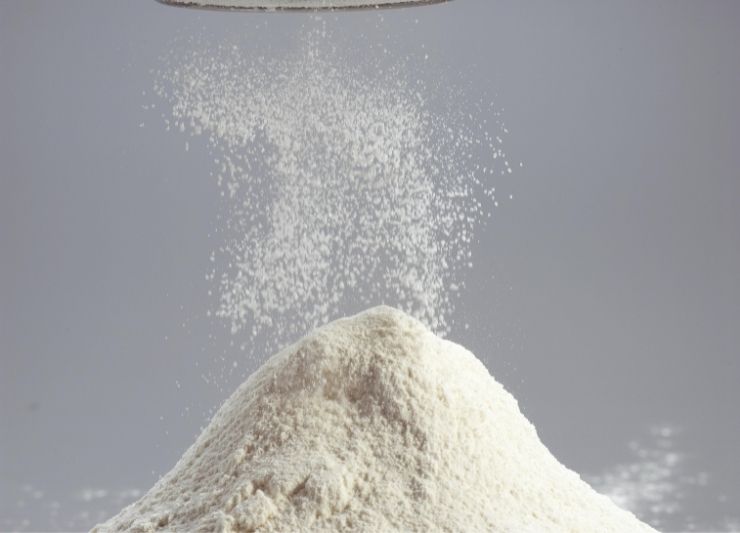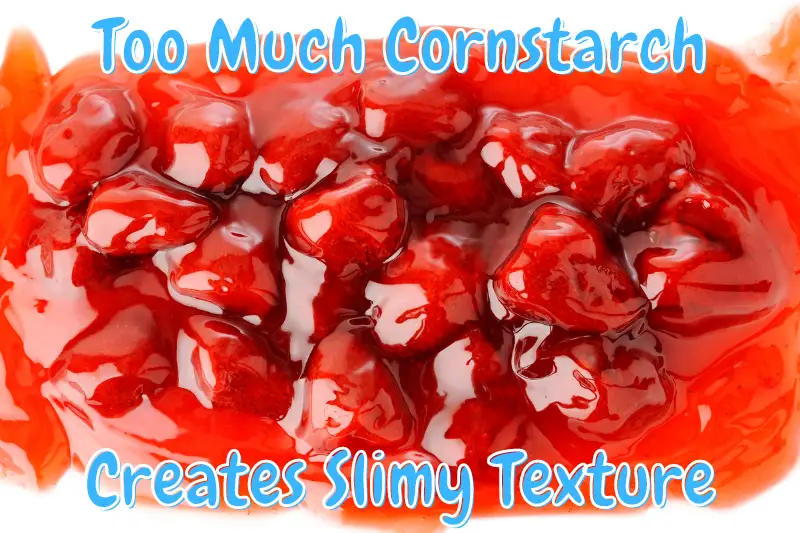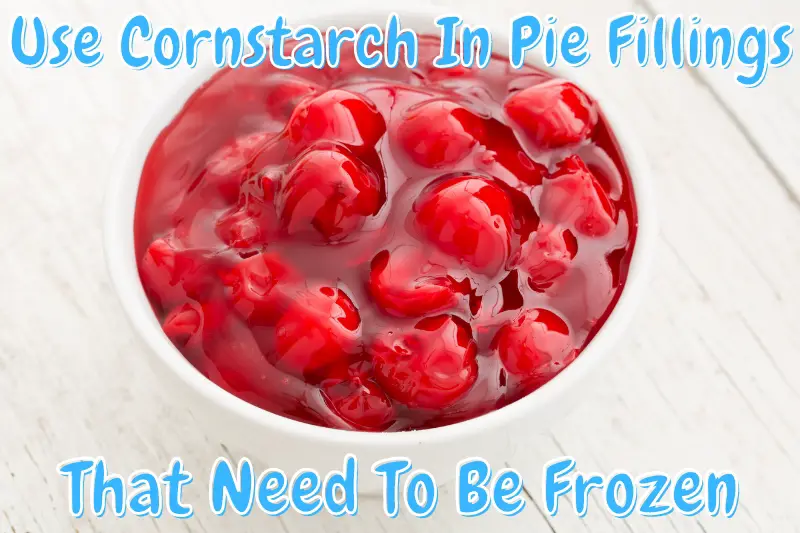This post contains affiliate links.
Do you have a pie recipe that calls for a thickener? If so, you’ll want to check out this list of the 8 best pie thickeners that helped me get the thickness of my pies just right!
Generally speaking, cornstarch is the best pie thickener because it’s very effective at thickening pie fillings. It’s also inexpensive and easy to find. Cornstarch tends to add a cloudy appearance to your filling, so if you want a clear filling, you’ll want to use one of many thickeners.
There are many different types of thickeners that can be used in pie fillings, and each one has its own unique set of benefits. I’ll discuss the different options so you can choose the right one for your recipe!
Why is Your Pie Filling Runny?
As a general rule, your pie filling might be runny because the filling wasn’t cooked long enough or if there are not enough pie thickeners used. If you don’t cook the filling long enough, the water in the ingredients won’t have time to evaporate, resulting in a runny filling.

To bake a perfect pie, you’ll need to use a great pan. I recently came across this 9-Inch Non-Stick Aluminized Steel Pie Pan that is great for baking a pie. This pie pan is coated with a silicone called Americoat that prevents the pie from sticking. You can check out this pan on Amazon!
8 Best Pie Thickeners
Pies are a staple dessert for many holidays like Thanksgiving and Christmas! Having a soggy pie is troublesome but not the end of the world. Thankfully, there are many thickeners that can be used to help save the day!
Here are some popular thickeners that can be used in pies:
| Type Of Thickener | What It’s Used For |
|---|---|
| Cornstarch | A good thickener for fruit pies |
| Tapioca Flour | A good choice if you want a clear filling |
| Arrowroot Flour | A good choice if you want a clear filling |
| Clear Jel or Instant Clear Jel | It will thicken your filling quicker |
| Xanthan Gum | It’s used as a thickener, emulsifier, and stabilizer |
| All-Purpose Flour | It’s effective but can make your filling cloudy |
| Chia Seeds | A good choice for a wetter pie filling |
| Psyllium Husk Powder | A good choice for a wetter pie filling |
Cornstarch
Cornstarch is a good thickener for fruit pies. It helps give the filling a slightly gooey texture since it absorbs the excess moisture from the filling.
To use cornstarch as a thickener, mix it with the other dry ingredients before adding wet ingredients. Once the wet ingredients are added, whisk vigorously to break up any lumps.
Cook the filling long enough, so the cornstarch has a chance to cook and thicken the filling. If you don’t cook it long enough, your filling will be runny.
Tapioca Flour
The small tapioca pearls used in bubble tea are made from tapioca flour. This flour is also effective at thickening pie fillings.
It’s clear when it’s cooked, so tapioca flour is a good choice if you want a clear filling.
Adding too much tapioca flour to your filling can make it gummy, so be sure to use the right amount. It also adds a distinctively floury taste. Tapioca works well for less juicy fruits, such as apples and blueberries.
Arrowroot Flour
Arrowroot flour is another good choice for thickening pie fillings. It’s similar to tapioca flour, but it doesn’t have the same floury taste.
Arrowroot flour is a good choice if you want a clear filling.
Take your prepared filling and mix in the arrowroot flour. For every cup of filling, add 1 tablespoon of arrowroot flour. Stir until the arrowroot flour is evenly distributed.
Be sure to cook the filling long enough, so the arrowroot flour has a chance to work. If you don’t cook it long enough, your filling will remain runny.
Clear Jel or Instant Clear Jel
Clear Jel is a cornstarch-based thickener that’s designed for use in pies. It’s clear when cooked, so it won’t make your filling cloudy.
Clear Jel comes in two forms: regular and instant. Instant clear jel is pre-gelatinized, which will thicken your filling more quickly.
To use either type of clear jel, mix it with the other dry ingredients before adding wet ingredients. Once the wet ingredients are added, whisk vigorously to break up any lumps.
Regular clear jel is typically sold in bulk and can be found online or at specialty stores. Instant clear jel can be found online or at some supermarkets.
*By the way, I recently wrote an article about The Best Ways To Prevent A Soggy Pie Crust. This article breaks down all the ways to make sure your crust does not come out soggy after it’s baked. You can check out this article here!
Xanthan Gum
Xanthan gum is a popular food additive used as a thickener, emulsifier, and stabilizer. It’s effective at thickening pie fillings but can be tricky to use because it’s very powerful.
A little goes a long way with xanthan gum.
If you use too much xanthan gum, your filling will be slimy. So, it’s important to use the right amount. For every cup of filling, add 1/4 teaspoon of xanthan gum.
Mix the xanthan gum with the other dry ingredients to avoid lumps before adding wet ingredients. Once the wet ingredients are added, whisk vigorously to break up any lumps.
Flour
All-purpose flour can be used to thicken pie fillings. It’s effective but can make your filling cloudy. If you want a clear filling, use another type of flour.

Take your prepared filling and mix in the flour. For every cup of filling, add 2 tablespoons of all-purpose flour. Stir until the flour is evenly distributed.
The best tool that I’ve found to sift my flour is a Battery Operated Electric Flour Sifter For Baking. This wonderful tool automates all of my sifting needs in the kitchen! It has a 4-cup capacity and is washable. What else do you need in an automatic sifter? You can check out this Electric Flour Sifter on Amazon!
Chia Seeds
Chia seeds are a popular superfood that’s often used as a thickener. When chia seeds are added to liquid, they absorb the liquid and swell up.
This makes them effective at thickening pie fillings. Chia seeds also add nutrition to your filling. They’re a good source of fiber, protein, and omega-3 fatty acids.
Make sure to not put a lot of chia seeds into the filling because some seeds might not absorb the moisture which will cause an undesired crunchy texture. I would use no more than a tablespoon if your pie is very soupy.
If your pie is only slightly on the wetter side, use up to half of a teaspoon.
Chia seeds usually take 24 hours to thicken. It has to sit overnight in the fridge before serving or baking.
Psyllium Husk Powder
Psyllium husk powder is a type of soluble fiber that’s often used as a thickener. When psyllium husk powder is added to liquid, it absorbs the liquid and forms a gel-like substance.
This makes it effective at thickening pie fillings.
Psyllium husk powder is also a good source of fiber. It’s often used as a dietary supplement to help with constipation and other digestive issues.
Is Flour or Cornstarch Better for Pie Filling?
As a general rule, cornstarch is more effective at thickening pie fillings than flour. This is because cornstarch forms a gel-like substance when it’s mixed with liquid, which helps to thicken the filling. However, both flour and cornstarch can be used to thicken pie filling.
Below, I found a video that compares the two side by side to know which pie filling is the best:
Flour can also be used to thicken pie filling, but it doesn’t work as well as cornstarch. This is because flour can make the filling cloudy. If you want a clear filling, use cornstarch instead of flour.
How Do You Fix Runny Pie Filling After Baking?
As a whole, allow the pie to cool completely. After that, put it back in the oven and activate the starch with a little more heat. This should help to thicken the filling. You can also drain off some of the liquid if it’s still runny.
According to KingArthurBaking:
“Cornstarch has thickening power similar to Instant ClearJel. Like flour, it lends a cloudy, semi-transparent look to filling. It can also give filling a starchy taste. For full effectiveness, make sure the pie filling is bubbling up through the crust before removing your pie from the oven.”
kingarthurbaking
*By the way, I recently wrote an article about How To Fix A Runny Pie After It’s Baked. This article breaks down all the ways to fix the filling of a baked pie that is still runny. You can check out this article here!
What Happens If You Put Too Much Cornstarch in Pie?
Generally speaking, If you put too much cornstarch in your pie, it will create a slimy texture. This is because cornstarch forms a gel-like substance when mixed with liquid. Too much cornstarch will make your pie filling too thick and overly gelled.
It’s always easy to add more cornstarch rather than remove it. When you’re making the filling and you notice that your mixture is still very runny, add your cornstarch. Do NOT add too much!
With cornstarch, less is more.

It is very tempting to add more when you see that your mixture hasn’t thickened to the desired consistency. This is because cornstarch requires heat to activate the thickening. Once your pie is baked, it will thicken.
*By the way, I recently wrote about How To Effectively Use Pie Weights The Right Way. In this article, I speak about how to use pie weights correctly to get the perfect shaped pie every time. You can check out this article here!
What is the Best Starch to Use in Pie Fillings That Are to Be Frozen?
As a general rule, cornstarch is the best starch to use in pie fillings that are to be frozen. This is because it’s more effective at thickening than flour and doesn’t make the filling cloudy. They also work best with reheating because the cornstarch has already been activated.
There were many times when I would have too much pie left over after a Thanksgiving meal and then be off traveling during the long weekend.
To prevent my pies from spoiling, I would store them in the freezer. However, there were many times that I had runny pies which required a thickener.
I found that using cornstarch is the best thickener if you’re planning on freezing pies.

This is because the cornstarch activates quickly in the oven and finished thickening the filling within the original cook time. If you reheat the frozen pie, it won’t continue to thicken and it won’t become cloudy in color.
*By the way, I recently wrote an article breaking down The Best Ways To Store A Pie To Make It Last Longer. This article talks about the right way to store your pies at room temperature, in a container, in the fridge, and in the freezer. You can check out this article here!
Final Thoughts
Pies have such a large variety of shapes and flavors. It’s a staple at many holiday dinners and a joy to eat! Runny pies can sour your mood but these thickening agents should help fix any runny pie!

